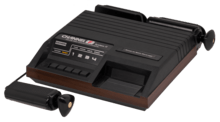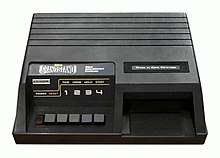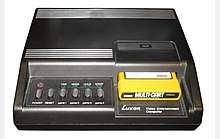Fairchild Channel F
The Fairchild Channel F, short for "Channel Fun,"[2] was the first programmable ROM cartridge–based video game console, and the first console to use a microprocessor. It was released by Fairchild Camera and Instrument in November 1976 across North America[3] at a retail price of US$169.95 (equivalent to $763.58 in 2019). It was also released in Japan (チャンネル F) in October the following year. It was originally named "Video Entertainment System," but when Atari, Inc. released its Video Computer System the next year, Fairchild changed the name for its machine, although they continued to use the old name alongside it.
 A Fairchild Channel F and its two accompanying game controllers | |
| Also known as | Fairchild Video Entertainment System |
|---|---|
| Manufacturer | Fairchild Camera and Instrument |
| Type | Home video game console |
| Generation | Second generation |
| Release date | |
| Lifespan | 1976–1983 |
| Introductory price | US$169 (equivalent to $759.31 in 2019) |
| Discontinued | 1983 |
| Units sold | c. 250,000 (as of 1977)[1] |
| CPU | Fairchild F8 |
| Memory | 64 bytes RAM 2 KB video buffer |
| Removable storage | ROM cartridge |
| Controller input |
|
| Successor | Channel F System II |
By 1977, the Fairchild Channel F had sold about 250,000 units, trailing behind sales of the VCS.[1]
In 1983, the production of the system discontinued.[4]
History
In 1974, Alpex Computer Corporation employees Wallace Kirschner and Lawrence Haskel developed a home video game prototype consisting of a base unit centered on an Intel 8080 microprocessor and interchangeable circuit boards containing ROM chips that could be plugged into the base unit. The duo attempted to interest several television manufacturers in the system, but were unsuccessful. Next, they contacted a buyer at Fairchild, which sent engineer Jerry Lawson to evaluate the system. Lawson was impressed by the system and suggested Fairchild license the technology, which the company did in January 1976.
Lawson worked with industrial designer Nick Talesfore and mechanical engineer Ron Smith to turn the prototype into a viable project. Changes included replacing the 8080 with Fairchild's own F8 CPU, adapting the prototypes complex keyboard controls into a single control stick, and encasing the ROM circuit boards in a plastic cartridges reminiscent of 8-track tapes.[5] Talesfore was responsible for the design of the hand controllers, console, and video game cartridges; Smith was responsible for the mechanical engineering of the video cartridges and controllers.
Channel F System II

Sometime in 1979, Zircon International bought the rights to the Channel F and released the re-designed console as the Channel F System II to compete with Atari's VCS. This re-designed System II was completed by Nick Talesfore at Fairchild. He was the same industrial designer who designed the original game console. Only six new games were released after the debut of the second system before its demise, several of which were developed at Fairchild before they sold it off.
The major changes were in design, with the controllers removable from the base unit instead of being wired directly into it; the controller storage was moved to the rear of the unit, and the sound was now mixed into the RF TV signal so the unit no longer needed a speaker. Electronics was also simplified with custom logic chips instead of standard logic resulting in a much smaller circuit board. This version also featured a simpler and more modern-looking case design.
Discontinuation
Following the video game crash of 1983, Fairchild left the market.
Licensed variants
A number of licensed versions were released in Europe, including the Luxor Video Entertainment System in Sweden, Adman Grandstand Video Entertainment Computer in the UK, the SABA Videoplay, ITT Telematch Processor and Nordmende Color TelePlay µP from Germany, and the Dumont Videoplay and Barco Challenger from the Barco/Dumont company in Italy and Belgium.



Design

The F8 was very complex compared to the typical integrated circuits of the day and had more inputs and outputs than other contemporary chips. Because chip packaging was not initially available with enough pins, the F8 used in the original form of the VES/Channel F (replaced by System II) was instead fabricated as a pair of chips that had to be used together to form a complete CPU. However, due to the F8's design, there was a considerable savings in terms of pins that enabled the inclusion of 64 bytes of internal scratchpad RAM. A single-chip variant of the F8 was used by both the System II and the VideoBrain computer system.
The Channel F is able to use one plane of graphics and one of four background colors per line, with three plot colors to choose from (red, green, and blue) that turned into white if the background is set to black, at a resolution of 128 × 64, with approximately 102 × 58 pixels visible and help from 64 bytes of system RAM, half the amount of the later Atari 2600.[6][7] The Maze game (cartridge 10) required 1K of on-cartridge static RAM, adding to the cost to manufacture it. The Chess game contained considerably more on-cartridge RAM than that. The F8 processor at the heart of the console is able to produce enough AI to allow for player versus computer matches, a first in console history. All previous machines required a human opponent. Tic-Tac-Toe on Videocart-1 had this feature, it was only for one player against the machine. The same is true for the chess game, which would have very long turn times for the computer as the game progressed.
In the original unit, sound is played through an internal speaker, rather than the TV set. However, the System II passed sound to the television through the RF modulator.
Controllers
The controllers are a joystick without a base; the main body is a large handgrip with a triangular "cap" on top, the top being the portion that actually moved for eight-way directional control. It could be used as both a joystick and paddle (twist), and not only could it be pushed down to operate as a fire button, it could be pulled up as well.[8] The model 1 unit contained a small compartment for storing the controllers when moving it. The System II featured detachable controllers and had two holders at the back to wind the cable around and to store the controller in. Zircon later offered a special control that featured an action button on the front of the joystick. It was marketed by Zircon as "Channel F Jet-Stick" in a letter sent out to registered owners before Christmas 1982.[9]
The functions printed on the console is how they work in the built-in games and also some of the original games: all buttons (except reset) are controlled by the programming and can be used for anything the programmer decides.
One feature unique of the console is the 'hold' button, which allows the player to freeze the game, change the time or change the speed of the game.[10] The hold function is not universal (like the hardwired reset).
Despite the failure of the Channel F, the joystick's design was so popular—Creative Computing called it "outstanding"— that Zircon also released an Atari joystick port-compatible version, the Video Command Joystick,[11] first released without the extra fire button. Before that, only the downwards plunge motion was connected and acted as the fire button; the pull-up and twist actions were not connected to anything.
Technical specifications

Original Channel F technical specifications:
- CPU microprocessor: Fairchild F8 (8-bit)[12] operating at 1.7897725 MHz (NTSC) (PAL gen. 1: 2.0000 MHz, PAL gen. 2: 1.7734475 MHz)
- RAM: 2 KB (128 × 64 × 2 bits)[13] for the framebuffer plus the 64 bytes of scratchpad memory.[14]
- Additional SRAM supported via add-in cartridges. Maze and Chess contain static RAM (SRAM), with the latter containing significantly more than the 1KB for Maze.
- Resolution: 128 × 64 pixels,[12] approximately 102×58 pixels visible depending on TV. Columns 125 and 126 controls palette (per row).
- Refresh rate: 60 Hz[15]
- Colors: 8 colors[12] (either black/white lines or one of three background colors per line combined with red, green or blue pixels)
- Audio: 120 Hz, 500 Hz and 1 kHz beeps (can be modulated to produce different tones). Quality is quite superior on the System II, versus the original model.
- Input: two custom game controllers, hardwired to the console (original release) or removable (Channel F System II)
- Output: RF modulated composite video signal, cord hardwired to console in gen. 1, detachable in gen. 2
Games
Twenty-seven cartridges, termed "Videocarts", were officially released to consumers in the United States during the ownership of Fairchild and Zircon, the first twenty-one of which were released by Fairchild. Several of these cartridges were capable of playing more than one game and were typically priced at $19.95.[16] The Videocarts were yellow and approximately the size and overall texture of an 8 track cartridge.[17] They usually featured colorful label artwork. The earlier artwork was created by nationally known artist Tom Kamifuji and art directed by Nick Talesfore. The console contained two built-in games, Tennis and Hockey, which were both advanced Pong clones. In Hockey, the reflecting bar could be changed to diagonals by twisting the controller and could move all over the playing field. Tennis was much like the original Pong.
A sales brochure from 1978 listed "Keyboard Videocarts" for sale. The three shown were K-1 Casino Poker, K-2 Space Odyssey, and K-3 Pro-Football. These were intended to use the Keyboard accessory. All further brochures, released after Zircon took over Fairchild, never listed this accessory nor anything called a Keyboard Videocart.
There was one additional cartridge released numbered Videocart-51 and simply titled "Demo 1". This Videocart was shown in a single sales brochure released shortly after Zircon acquired the company. It was never listed for sale after this single brochure which was used in the winter of 1979.
| Title | Release date | Genre |
|---|---|---|
| Democart | 1976[18] | System demonstration |
| Hockey (integrated) | 1976 | Sports |
| Tennis (integrated) | 1976 | Sports |
| Videocart-1: Tic-Tac-Toe, Shooting Gallery, Doodle, Quadra-Doodle | 1976 | Trivia, shooter |
| Videocart-2: Desert Fox, Shooting Gallery | 1976 | Action, shooter |
| Videocart-3: Video Blackjack | 1976 | Gambling |
| Videocart-4: Spitfire | 1977 | Action, shooter |
| Videocart-5: Space War | 1977 | Action, shooter |
| Videocart-6: Math Quiz I (Addition & Subtraction) | 1977 | Educational |
| Videocart-7: Math Quiz II (Multiplication & Division) | 1977 | Educational |
| Videocart-8: Magic Numbers (Mind Reader & Nim) | 1977 | Trivia |
| Videocart-9: Drag Race | 1977 | Racing |
| Videocart-10: Maze, Jailbreak, Blind-Man's-Bluff, Trailblazer | 1977 | Maze |
| Videocart-11: Backgammon, Acey-Deucey | 1977 | Trivia |
| Videocart-12: Baseball | 1977 | Sports |
| Videocart-13: Robot War, Torpedo Alley | 1977 | Platform, action |
| Videocart-14: Sonar Search | 1977 | Strategy |
| Videocart-15: Memory Match 1, Memory Match 2 | 1978 | Puzzle |
| Videocart-16: Dodge' It | 1978 | Platform, action |
| Videocart-17: Pinball Challenge | 1978 | Pinball |
| Videocart-18: Hangman | 1978 | Puzzle |
| Videocart-19: Checkers | 1978 | Trivia |
| Videocart-20: Video Whizball | 1978[18] | Miscellaneous |
| Videocart-21: Bowling | 1978 | Sports |
| Videocart-22: Slot Machine | 1980 | Gambling |
| Videocart-23: Galactic Space Wars | 1980 | Action, shooter |
| Videocart-24: Pro Football | 1981 | Sports |
| Videocart-25: Casino Poker | 1981 | Gambling |
| Videocart-26: Alien Invasion | 1981[18] | Action, shooter |
Unreleased carts:
- Keyboard Videocart-1: Casino Poker
- Keyboard Videocart-2: Space Odyssey
- Keyboard Videocart-3: Pro-Football
- Videocart-51: Demo 1[18]
Other official carts:
- Democart 2
German electronics manufacturer SABA also released a few compatible carts different from the original carts: translation in Videocart-1 Tic-Tac-Toe to German words; Videocart-3 released with different abbreviations (German); Videocart-18 changed graphics and German word list; and SABA 20, a chess game released only by SABA.
A clone of Pac-Man for the Channel F was released in 2009.[19]
Reception
Ken Uston reviewed 32 games in his book Ken Uston's Guide to Buying and Beating the Home Video Games in 1982, and rated some of the Channel F's titles highly; of these, Alien Invasion and Video Whizball were considered by Uston to be "the finest adult cartridges currently available for the Fairchild Channel F System".[20] The games on a whole, however, rated last on his survey of over 200 games for the Atari, Intellivision, Astrocade and Odyssey consoles, and contemporary games were rated "Average" with future Channel F games rated "below average".[21] Uston rated almost one-half of the Channel F games as "high in interest" and called that "an impressive proportion" and further noted that "Some of the Channel F cartridges are timeless; no matter what technological developments occur, they will continue to be of interest." His overall conclusion was that the games "serve a limited, but useful, purpose" and that the "strength of the Channel F offering is in its excellent educational line for children".[22]
In 1983, after Zircon announced its discontinuation of the Channel F, Video Games reviewed the console. Calling it "the system nobody knows", the magazine described its graphics and sounds as "somewhat primitive by today's standards". It described Space War as perhaps "the most antiquated game of its type still on the market", and rated the 25 games for the console with an average grade of three ("not too good") on a scale from one to ten. The magazine stated, however, that Fairchild "managed to create some fascinating games, even by today's standards", calling Casino Royale (Video Blackjack) "the best card game, from blackjack to bridge, made for any TV-game system". It also favorably reviewed Dodge-It ("simple but great"), Robot War ("Berzerk without guns"), and Whizball ("thoroughly original ... hockey with guns"), but concluded that only those interested in nostalgia, video game collecting, or card games would purchase the Channel F in 1983.[23]
See also
- TV POWWW
References
- Jones, Gareth R.; Hill, Charles W. L. (2007). Strategic management: an integrated approach (7th ed.). Boston: Houghton Mifflin. p. C-123. ISBN 0-618-73166-0. Retrieved February 25, 2012.
By this point, second-place Fairchild sold around 250,000 units of its system.
- Edwards, Benj (January 22, 2015). "The Untold Story Of The Invention Of The Game Cartridge". Fast Company. Retrieved January 7, 2019.
- "Fairchild Channel F Patent, FCC Approval, & Launch Brochure". Fndcollectables.com.
- Wolf, Mark J. P. (November 21, 2018). The Routledge Companion to Media Technology and Obsolescence. Routledge. ISBN 978-1-315-44266-2.
- Smith, Alexander (2019). They Create Worlds: The Story of the People and Companies That Shaped the Video Game Industry, Volume I. CRC Press. pp. 318–320. ISBN 9781138389908.
- "Archived copy". Archived from the original on July 25, 2011. Retrieved February 5, 2016.CS1 maint: archived copy as title (link)
- "Archived copy". Archived from the original on July 25, 2011. Retrieved February 5, 2016.CS1 maint: archived copy as title (link)
- Vinciguerra, Robert. "Fairchild Channel F Video Entertainment System: The first modern game console". The Rev. Rob Times. Retrieved January 6, 2014.
- "Channel F Jet-Stick Advert" (JPG). Fndcollectables.com. Retrieved January 7, 2019.
- "OLD-COMPUTERS.COM : The Museum". Old-computers.com. Archived from the original on June 30, 2018. Retrieved January 7, 2019.
- Ahl, David H.; Rost, Randi J. (1983), "Blisters And Frustration: Joysticks, Paddles, Buttons and Game Port Extenders for Apple, Atari and VIC", Creative Computing Video & Arcade Games, 1 (1): 106ff.
- "Home Page". Video Game Console Library. Retrieved January 7, 2019.
- Wolf, Mark J. P. (June 15, 2012). "Before the Crash: Early Video Game History". Wayne State University Press. Retrieved January 7, 2019 – via Google Books.
- "Fairchild Channel F". www.oldcomputers.it. Retrieved February 29, 2020.
- As emulated by MAME; see source code at "MAME". GitHub. Archived from the original on July 7, 2019. Retrieved July 7, 2019.
- 1976 commercial trailer: https://m.youtube.com/watch?v=jXvpsmanhsk
- Kent, Steven L. (2001). The Ultimate History of Video Games. Three Rivers Press. ISBN 0-7615-3643-4.
- Wolf, Mark J. P. (2012). Before the Crash: Early Video Game History. Wayne State University Press. p. 70.
- "Channel F – Videocart 27: Pac-Man (USC)". ConsoleCity. Retrieved January 7, 2019.
- Uston, Ken. Ken Uston's Guide to Buying and Beating the Home Video Games (Signet, 1982) p.605
- Uston, Ken. Ken Uston's Guide to Buying and Beating the Home Video Games (Signet, 1982) p.20.
- Uston, Ken. Ken Uston's Guide to Buying and Beating the Home Video Games (Signet, 1982) p.603 and p.23.
- Dionne, Roger (March 1983). "Channel F: The System Nobody Knows". Video Games. pp. 73–75. Retrieved May 26, 2014.
External links
| Wikimedia Commons has media related to Fairchild Channel F. |
- The Dot Eaters article with a history of the Channel F and games
- Interview with designer Jerry Lawson
- MobyGames list of Channel F games
- Channel F wiki and gallery of labels, instructions, boxes
- Patent: Cartridge programmable video game apparatus US 4095791 A
- The Untold Story of the Invention of the Video Game Cartridge - how the Channel F's video game cartridge was created (January 22, 2015).
- Channel F was 1977’s top game system—before Atari wiped it out at The A.V. Club's AUX (4/09/2017)
- Channel F games playable for free in the browser at the Internet Archive Console Living Room.